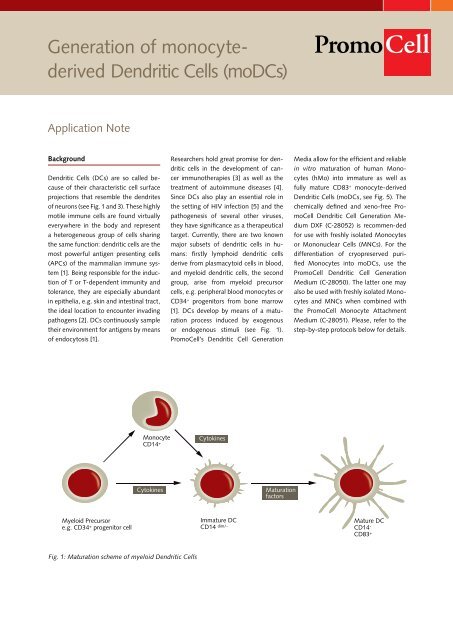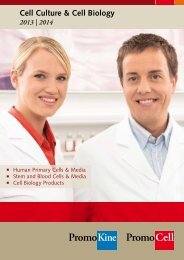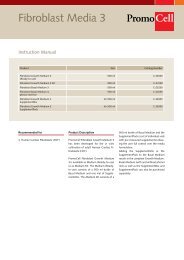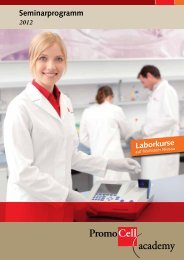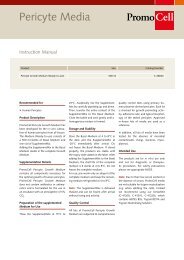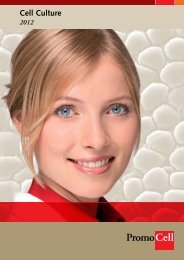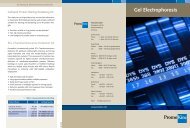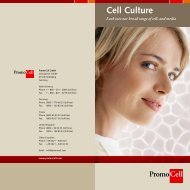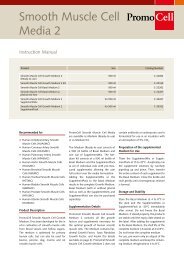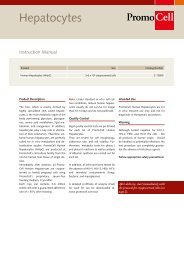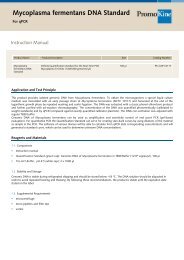Generation of monocyte- derived Dendritic Cells (moDCs) - PromoCell
Generation of monocyte- derived Dendritic Cells (moDCs) - PromoCell
Generation of monocyte- derived Dendritic Cells (moDCs) - PromoCell
You also want an ePaper? Increase the reach of your titles
YUMPU automatically turns print PDFs into web optimized ePapers that Google loves.
<strong>Generation</strong> <strong>of</strong> <strong>monocyte</strong><strong>derived</strong><br />
<strong>Dendritic</strong> <strong>Cells</strong> (<strong>moDCs</strong>)<br />
Application Note<br />
Background<br />
<strong>Dendritic</strong> <strong>Cells</strong> (DCs) are so called be-<br />
cause <strong>of</strong> their characteristic cell surface<br />
projections that resemble the dendrites<br />
<strong>of</strong> neurons (see Fig. 1 and 3). These highly<br />
motile immune cells are found virtually<br />
everywhere in the body and represent<br />
a heterogeneous group <strong>of</strong> cells sharing<br />
the same function: dendritic cells are the<br />
most powerful antigen presenting cells<br />
(APCs) <strong>of</strong> the mammalian immune system<br />
[1]. Being responsible for the induction<br />
<strong>of</strong> T or T-dependent immunity and<br />
tolerance, they are especially abundant<br />
in epithelia, e.g. skin and intestinal tract,<br />
the ideal location to encounter invading<br />
pathogens [2]. DCs continuously sample<br />
their environment for antigens by means<br />
<strong>of</strong> endocytosis [1].<br />
Myeloid Precursor<br />
e.g. CD34 + progenitor cell<br />
Monocyte<br />
CD14 +<br />
Cytokines<br />
Fig. 1: Maturation scheme <strong>of</strong> myeloid <strong>Dendritic</strong> <strong>Cells</strong><br />
Researchers hold great promise for dendritic<br />
cells in the development <strong>of</strong> cancer<br />
immunotherapies [3] as well as the<br />
treatment <strong>of</strong> autoimmune diseases [4].<br />
Since DCs also play an essential role in<br />
the setting <strong>of</strong> HIV infection [5] and the<br />
pathogenesis <strong>of</strong> several other viruses,<br />
they have significance as a therapeutical<br />
target. Currently, there are two known<br />
major subsets <strong>of</strong> dendritic cells in humans:<br />
firstly lymphoid dendritic cells<br />
derive from plasmacytoid cells in blood,<br />
and myeloid dendritic cells, the second<br />
group, arise from myeloid precursor<br />
cells, e.g. peripheral blood <strong>monocyte</strong>s or<br />
CD34 + progenitors from bone marrow<br />
[1]. DCs develop by means <strong>of</strong> a maturation<br />
process induced by exogenous<br />
or endogenous stimuli (see Fig. 1).<br />
<strong>PromoCell</strong>’s <strong>Dendritic</strong> Cell <strong>Generation</strong><br />
Cytokines<br />
Immature DC<br />
CD14 dim/-<br />
Maturation<br />
factors<br />
Media allow for the efficient and reliable<br />
in vitro maturation <strong>of</strong> human Monocytes<br />
(hMo) into immature as well as<br />
fully mature CD83 + <strong>monocyte</strong>-<strong>derived</strong><br />
<strong>Dendritic</strong> <strong>Cells</strong> (<strong>moDCs</strong>, see Fig. 5). The<br />
chemically defined and xeno-free <strong>PromoCell</strong><br />
<strong>Dendritic</strong> Cell <strong>Generation</strong> Medium<br />
DXF (C-28052) is recommen-ded<br />
for use with freshly isolated Monocytes<br />
or Mononuclear <strong>Cells</strong> (MNCs). For the<br />
differentiation <strong>of</strong> cryopreserved purified<br />
Monocytes into <strong>moDCs</strong>, use the<br />
<strong>PromoCell</strong> <strong>Dendritic</strong> Cell <strong>Generation</strong><br />
Medium (C-28050). The latter one may<br />
also be used with freshly isolated Monocytes<br />
and MNCs when combined with<br />
the <strong>PromoCell</strong> Monocyte Attachment<br />
Medium (C-28051). Please, refer to the<br />
step-by-step protocols below for details.<br />
Mature DC<br />
CD14 -<br />
CD83 +
2<br />
Application Note - <strong>Generation</strong> <strong>of</strong> <strong>monocyte</strong>-<strong>derived</strong> <strong>Dendritic</strong> <strong>Cells</strong> (moDC)<br />
Use aseptic techniques and a laminar flow bench.<br />
<strong>Generation</strong> <strong>of</strong> <strong>moDCs</strong> from Freshly Isolated <strong>Cells</strong><br />
For <strong>Generation</strong> <strong>of</strong> <strong>moDCs</strong> from freshly isolated peripheral blood Monocytes or<br />
Mononuclear <strong>Cells</strong>, <strong>PromoCell</strong> recommends the use <strong>of</strong> the <strong>Dendritic</strong> Cell <strong>Generation</strong><br />
Medium DXF (C-28052). Refer to protocol A for details.<br />
Alternatively, the <strong>Dendritic</strong> Cell <strong>Generation</strong> Medium (C-28050) in combination with<br />
the Monocyte Attachment Medium (C-28051) may be used. See protocol B for detailed<br />
procedure.<br />
Protocol A: <strong>Generation</strong> <strong>of</strong> <strong>moDCs</strong> from freshly isolated cells using DC <strong>Generation</strong><br />
Medium DXF (C-28052)<br />
1. Let the cells attach (day 0)<br />
Plate freshly isolated cells in an appropriate amount <strong>of</strong> <strong>PromoCell</strong> DC <strong>Generation</strong><br />
Medium DXF w/o cytokines. Mononuclear <strong>Cells</strong> at a density <strong>of</strong> 2-3 million/cm2<br />
and purified Monocytes at 0.5 million/cm2 . Incubate for 1 hour at 5% CO and 2<br />
37°C in the incubator.<br />
2. Wash the adherent cell fraction (day 0)<br />
By vigorously swirling the tissue culture vessel loosen non-adherent cells and<br />
aspirate them. Wash the adherent cells three times with warm <strong>PromoCell</strong> DC<br />
<strong>Generation</strong> Medium DXF w/o cytokines by swirling the vessel and aspirating the<br />
supernatant.<br />
3. Start differentiation into immature moDC (day 0)<br />
Add an appropriate amount <strong>of</strong> <strong>PromoCell</strong> DC <strong>Generation</strong> Medium DXF supplemented<br />
with 1x Component A <strong>of</strong> the Cytokine Pack moDC DXF and incubate for<br />
3 days at 37°C and 5% CO . 2<br />
4. Medium change (day 3)<br />
Perform a medium change on day 3: Aspirate the medium from the cells and collect<br />
it in a centrifugation tube. Immediately, pipet fresh <strong>PromoCell</strong> DC <strong>Generation</strong><br />
Medium DXF supplemented with 1x Component A <strong>of</strong> the Cytokine Pack moDC<br />
DXF to the cells. Centrifuge the cells in the tube for 10 min at 180 x g. Discard the<br />
supernatant and carefully resuspend the cells in a small amount <strong>of</strong> fresh medium.<br />
Combine the resuspended cells in the tube with the cells in the fresh medium<br />
contained in the tissue culture vessel. Incubate the immature <strong>moDCs</strong> for another<br />
3 days at 37°C and 5% CO . 2<br />
Note: Adherent / loosely attached as well as non-adherent cells may be observed<br />
at this stage. Immature moDC, also termed “veiled cells”, appear as irregularly<br />
outlined cells, occasionally exhibiting large cytoplasmic processes (“veils”, see Fig.<br />
2). They show a CD45 + / CD83- phenotype and stain negative to moderately<br />
positive for CD14.<br />
5. Complete moDC maturation process (day 6)<br />
To complete the moDC maturation process, supplement the whole volume with<br />
1x <strong>of</strong> Component B <strong>of</strong> the Cytokine Pack moDC DXF on day 6. Do not change the<br />
medium. Incubate at 37°C and 5% CO for an additional 24-48 hours.<br />
2<br />
<strong>Generation</strong> <strong>of</strong><br />
<strong>moDCs</strong> from<br />
Freshly Isolated<br />
<strong>Cells</strong>
Use aseptic techniques and a laminar flow bench.<br />
6. Harvest mature moDC (day 7 / 8)<br />
Dislodge loosely attached cells by pipetting up and down several times. Transfer<br />
the medium containing the cells in a 50 ml tube. Spin down harvested <strong>moDCs</strong> at<br />
180 x g for 10 minutes and discard the supernatant.<br />
Note: Mature <strong>moDCs</strong> are non-adherent cells and exhibit a unique morphology<br />
originating from their multiple long thread-like dendrites (see Fig. 3).<br />
7. Perform your experiments<br />
Resuspend and count the cells. The <strong>moDCs</strong> are now ready to be used in your<br />
experiments. Optionally, characterize their dendritic cell immuno-phenotype, e.g.<br />
by performing flow cytometry analysis for CD14, CD45 and CD83.<br />
Note: Mature <strong>moDCs</strong> generated in the <strong>PromoCell</strong> DC <strong>Generation</strong> Medium DXF<br />
supplemented with the Cytokine Pack moDC exhibit a CD14- / CD45 + / CD83 +<br />
phenotype (see Fig. 4 and 5).<br />
Protocol B: <strong>Generation</strong> <strong>of</strong> <strong>moDCs</strong> from freshly isolated cells using DC <strong>Generation</strong><br />
Medium (C-28050) and Monocyte Attachment Medium (C-28051)<br />
1. Let the cells attach (day 0)<br />
Plate freshly isolated cells in an appropriate amount the <strong>PromoCell</strong> Monocyte<br />
Attachment Medium. Plate Mononuclear <strong>Cells</strong> at a density <strong>of</strong> 2-3 million/cm 2 and<br />
purified Monocytes at 0.5 million/cm2 . Incubate for 1 hour at 5% CO and 37°C<br />
2<br />
in the incubator.<br />
2. Wash the adherent cell fraction (day 0)<br />
By vigorously swirling the tissue culture vessel loosen non-adherent cells and aspirate<br />
them. Wash the adherent cells three times with warm Monocyte Attachment<br />
Medium by swirling the vessel and aspirating the supernatant.<br />
3. Start differentiation into immature moDC (day 0)<br />
Add an appropriate amount <strong>of</strong> <strong>PromoCell</strong> <strong>Dendritic</strong> Cell <strong>Generation</strong> Medium<br />
supplemented with 1x Component A <strong>of</strong> the Cytokine Pack moDC and incubate<br />
for 3 days at 37°C and 5% CO . 2<br />
Application Note - <strong>Generation</strong> <strong>of</strong> <strong>monocyte</strong>-<strong>derived</strong> <strong>Dendritic</strong> <strong>Cells</strong> (moDC) 3<br />
Fig. 2: Day 6 immature <strong>monocyte</strong>-<strong>derived</strong><br />
<strong>Dendritic</strong> <strong>Cells</strong> (<strong>moDCs</strong>). Note the large cytoplasmic,<br />
veil-like processes seen in adherent<br />
(center) as well as loosely attached (upper left)<br />
cells.<br />
<strong>Generation</strong> <strong>of</strong><br />
<strong>moDCs</strong> from<br />
Freshly Isolated<br />
<strong>Cells</strong>
4<br />
Application Note - <strong>Generation</strong> <strong>of</strong> <strong>monocyte</strong>-<strong>derived</strong> <strong>Dendritic</strong> <strong>Cells</strong> (moDC)<br />
Use aseptic techniques and a laminar flow bench.<br />
4. Medium Change (day 3)<br />
Perform a medium change on day 3: Aspirate the medium from the cells and<br />
collect it in a centrifugation tube. Immediately, pipet fresh <strong>PromoCell</strong> DC <strong>Generation</strong><br />
Medium supplemented with 1x Component A <strong>of</strong> the Cytokine Pack moDC<br />
to the cells. Centrifuge the cells in the tube for 10 min at 180 x g. Discard the<br />
supernatant and carefully resuspend the cells in a small amount <strong>of</strong> fresh medium.<br />
Combine the resuspended cells in the tube with the cells in the fresh medium<br />
contained in the tissue culture vessel. Incubate the immature <strong>moDCs</strong> for another<br />
3 days at 37°C and 5% CO . 2<br />
Note: Adherent / loosely attached as well as non-adherent cells may be observed<br />
at this stage. Immature moDC, also termed “veiled cells”, appear as irregularly<br />
outlined cells, occasionally exhibiting large cytoplasmic processes (“veils”, see Fig.<br />
2). They show a CD45 + / CD83- phenotype and stain negative to moderately<br />
positive for CD14.<br />
5. Complete moDC maturation process (day 6)<br />
To complete the moDC maturation process, supplement the whole volume with<br />
1x <strong>of</strong> Component B <strong>of</strong> the Cytokine Pack moDC DXF on day 6. Do not change the<br />
medium. Incubate at 37°C and 5% CO for an additional 24-48 hours.<br />
2<br />
6. Harvest mature moDC (day 7 / 8)<br />
Dislodge loosely attached cells by pipetting up and down several times. Transfer<br />
the medium containing the cells in a 50 ml tube. Spin down harvested <strong>moDCs</strong> at<br />
180 x g for 10 minutes and discard the supernatant.<br />
Note: Mature <strong>moDCs</strong> are non-adherent cells and exhibit a unique morphology<br />
originating from their multiple long thread-like dendrites (see Fig. 3).<br />
7. Perform your experiments<br />
Resuspend and count the cells. The <strong>moDCs</strong> are now ready to be used in your<br />
experiments.<br />
Optionally, characterize their dendritic cell immuno-phenotype, e.g. by performing<br />
flow cytometry analysis for CD14, CD45 and CD83.<br />
Note: Mature <strong>moDCs</strong> generated in the <strong>PromoCell</strong> DC <strong>Generation</strong> Medium supplemented<br />
with the Cytokine Pack moDC exhibit a CD14- / CD45 + / CD83 + phenotype<br />
(see Fig. 4 and 5).<br />
Fig. 3: Day 8 mature <strong>monocyte</strong>-<strong>derived</strong> <strong>Dendritic</strong><br />
Cell (moDC). Note the multiple dendritelike<br />
structures arising from the surface <strong>of</strong> this<br />
non-adherent cell.<br />
<strong>Generation</strong> <strong>of</strong><br />
<strong>moDCs</strong> from<br />
Freshly Isolated<br />
<strong>Cells</strong>
Use aseptic techniques and a laminar flow bench.<br />
<strong>Generation</strong> <strong>of</strong> <strong>moDCs</strong> from Cryopreserved <strong>Cells</strong><br />
For <strong>Generation</strong> <strong>of</strong> <strong>moDCs</strong> from cryopreserved peripheral blood Monocytes, Promo-<br />
Cell recommends the use <strong>of</strong> the <strong>Dendritic</strong> Cell <strong>Generation</strong> Medium (C-28050).<br />
1. Plate the cells (day 0)<br />
Thaw cryopreserved <strong>monocyte</strong>s in a waterbath according to the Instruction Manual<br />
delivered with the cells. After thawing, immediately plate them at 0.5 million/<br />
cm2 in an appropriate amount <strong>of</strong> <strong>PromoCell</strong> <strong>Dendritic</strong> Cell <strong>Generation</strong> Medium<br />
supplemented with 1x Component A <strong>of</strong> the Cytokine Pack moDC. Use at least 9 ml<br />
medium per vial <strong>of</strong> cryopreserved cells. Immediately place them in an incubator for<br />
1 day at 37°C and 5% CO . 2<br />
Note: It is important to leave the cells untouched for at least 16 hours in order to<br />
prevent excessive clumping.<br />
2. Medium change (day 1)<br />
Aspirate the medium from the cells and collect it in a centrifugation tube.<br />
Immediately pipet fresh <strong>PromoCell</strong> <strong>Dendritic</strong> Cell <strong>Generation</strong> Medium<br />
supplemented with 1x Component A <strong>of</strong> the Cytokine Pack moDC to the cells.<br />
Centrifuge the cells in the tube for 10 min at 180 x g. Discard the supernatant<br />
and carefully resuspend the cells in a small amount <strong>of</strong> fresh medium. Combine the<br />
resuspended cells with the cells in the fresh medium contained in the tissue culture<br />
vessel. Incubate for 3 more days.<br />
3. Medium change (day 4)<br />
Perform a medium change as described above. Incubate for a further 2 days at<br />
37°C and 5% CO . 2<br />
Note: Adherent / loosely attached as well as non-adherent cells may be observed<br />
at this stage. Immature moDC, also termed “veiled cells”, appear as irregularly<br />
outlined cells, occasionally exhibiting large cytoplasmic processes (“veils”, see<br />
Fig. 2). They show a CD45 + / CD83- phenotype and stain negative to moderately<br />
positive for CD14.<br />
4. Complete moDC maturation process (day 6)<br />
To complete the moDC maturation process, supplement the whole volume with<br />
1x <strong>of</strong> Component B <strong>of</strong> the Cytokine Pack moDC on day 6. Do not change the<br />
medium. Incubate at 37°C and 5% CO for an additional 24 to 48 hours.<br />
2<br />
5. Harvest mature moDC (day 7 / 8)<br />
Dislodge loosely attached cells by pipetting up and down several times. Transfer<br />
the medium containing the cells to a 50 ml tube. Spin down harvested <strong>moDCs</strong> at<br />
180 x g for 10 minutes and discard the supernatant.<br />
Note: Mature <strong>moDCs</strong> are non-adherent cells and exhibit a unique morphology<br />
originating from their multiple long thread-like dendrites (see Fig. 3).<br />
6. Perform your experiments<br />
Resuspend and count the cells. The moDC are now ready to be used in your<br />
experiments. Optionally, characterize their dendritic cell immuno-phenotype, e.g.<br />
by performing flow cytometry analysis for CD14, CD45 and CD83.<br />
Note: Mature <strong>moDCs</strong> generated in the <strong>PromoCell</strong> DC <strong>Generation</strong> Medium<br />
supplemented with the Cytokine Pack DC exhibit a CD14- / CD45 + / CD83 +<br />
phenotype (see Fig. 4 and 5).<br />
Application Note - <strong>Generation</strong> <strong>of</strong> <strong>monocyte</strong>-<strong>derived</strong> <strong>Dendritic</strong> <strong>Cells</strong> (moDC) 5<br />
<strong>Generation</strong> <strong>of</strong><br />
<strong>moDCs</strong> from<br />
Cryopreserved<br />
<strong>Cells</strong>
cell count<br />
cell count<br />
0<br />
0<br />
6<br />
Application Note - <strong>Generation</strong> <strong>of</strong> <strong>monocyte</strong>-<strong>derived</strong> <strong>Dendritic</strong> <strong>Cells</strong> (moDC)<br />
.<br />
CD14-<br />
CD83-<br />
CD14+<br />
10 1 10 2 10 3 10 4<br />
CD83+<br />
CD14<br />
10 1 10 2 10 3 10 4<br />
CD83<br />
Fig. 4: Flow-cytometry analysis <strong>of</strong> day 8 mature<br />
<strong>moDCs</strong> generated in the <strong>PromoCell</strong> DC<br />
<strong>Generation</strong> Medium. More than 98% <strong>of</strong> the<br />
cells are negative for CD14.*<br />
Fig. 5: Flow-cytometry analysis <strong>of</strong> day 8<br />
mature <strong>moDCs</strong> generated in the <strong>PromoCell</strong><br />
DC <strong>Generation</strong> Medium. More than 76% <strong>of</strong><br />
the cells are positive for the DC maturation<br />
marker CD83.*<br />
* Best results are observed with fresh cells from peripheral blood / buffy coats isolated within 8 hours <strong>of</strong> blood collection. Note that the yield <strong>of</strong> in vitro<br />
generated moDC may vary based on donor variation and the cell source used. Expect cell loss (<strong>monocyte</strong>s) within the first 2 days <strong>of</strong> the DC <strong>Generation</strong><br />
procedure.
References<br />
[1] Chung NP, Chen Y, Chan VS, Tam PK, Lin CL (2004). <strong>Dendritic</strong> cells: sentinels against pathogens. Histol Histopathol, 19(1):317-24.<br />
[2] Kubach J, Becker C, Schmitt E, Steinbrink K, Huter E, Tuettenberg A, Jonuleit H (2005). <strong>Dendritic</strong> cells: sentinels <strong>of</strong> immunity and<br />
tolerance. Int J Hematol, 81(3):197-203.<br />
[3] Banchereau J, Palucka AK (2005). <strong>Dendritic</strong> cells as therapeutic vaccines against cancer. Nat Rev Immunol, 5(4):296-306.<br />
[4] Ohnmacht C, Pullner A, King SBS, Drexler I, Meier S, Brocker T, Voehringer D (2009). Constitutive ablation <strong>of</strong> dendritic cells breaks<br />
self-tolerance <strong>of</strong> CD4 T cells and results in spontaneous fatal autoimmunity. J Exp Med, 206(3):549–59.<br />
[5] Lo P (2003). HIV hijacks dendritic cells. Nat Med, 9:650.<br />
Related Products<br />
Product Size Catalog Number<br />
DC <strong>Generation</strong> Medium (Ready-to-use) 250 ml C-28050<br />
DC <strong>Generation</strong> Medium DXF<br />
(Ready-to-use)<br />
250 ml C-28052<br />
DC Base Medium 250 ml C-28053<br />
DC Base Medium DXF 250 ml C-28054<br />
Monocyte Attachment Medium<br />
(Ready-to-use)<br />
250 ml C-28051<br />
Human CD14 + Monocytes from Peripheral<br />
Blood (hMoCD14 + -PB), single donor,<br />
pre-screened<br />
10 x 106 cryopreserved cells C-12912<br />
Human CD34 + Progenitor <strong>Cells</strong> from Cord<br />
Blood (hCD34 + -CB), single donor<br />
100,000 cryopreserved cells C-12921<br />
Human CD34 + Progenitor <strong>Cells</strong> from Cord<br />
Blood (hCD34 + -CB), pooled<br />
100,000 cryopreserved cells C-12924<br />
Mononuclear Cell Medium (Ready-to-use) 500 ml C-28030<br />
IL-6 CC, human, recombinant 10 µg C-61601<br />
GM-CSF, human, recombinant (E. coli) 10 µg C-60420<br />
IL-1 beta, human, recombinant 10 µg C-61120<br />
IL-4 CC, human, recombinant 5 µg C-61401<br />
sCD40 Ligand (CD154), human, recombinant<br />
50 µg C-63100<br />
TNF-alpha, human, recombinant (E. coli) 50 µg C-63719<br />
IFN-alpha 1, human, recombinant (E. coli) 20 µg C-60577<br />
<strong>PromoCell</strong> GmbH<br />
Sickingenstr. 63/65<br />
69126 Heidelberg<br />
Germany<br />
Email: info@promocell.com<br />
www.promocell.com<br />
North America<br />
Phone: 1 – 866 – 251 – 2860 (toll free)<br />
Fax: 1 – 866 – 827 – 9219 (toll free)<br />
Deutschland<br />
Telefon: 0800 – 776 66 23 (gebührenfrei)<br />
Fax:<br />
France<br />
0800 – 100 83 06 (gebührenfrei)<br />
Téléphone: 0800 90 93 32 (ligne verte)<br />
Téléfax: 0800 90 27 36 (ligne verte)<br />
United Kingdom<br />
Phone: 0800 – 96 03 33 (toll free)<br />
Fax: 0800 – 169 85 54 (toll free)<br />
Other Countries<br />
Phone: +49 6221 – 649 34 0<br />
Fax: +49 6221 – 649 34 40


